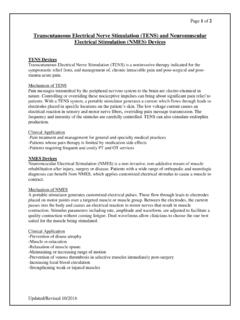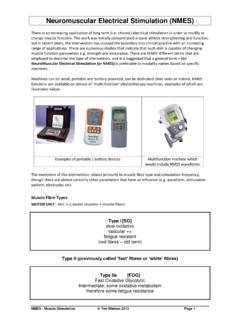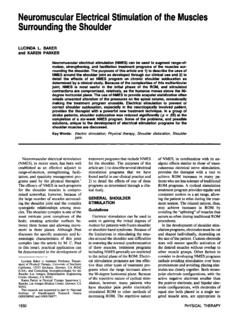Transcription of Effect of neuromuscular electrical stimulation …
1 Effect of neuromuscular electrical stimulation (NMES) on tibialis anterior in children with cerebral palsy. Carla de Conti PT; Enrico Trevisi MD; Annamaria Salghetti MD. E. Medea Scientific Institute, Conegliano Research Center, Conegliano (TV), Italy. Correspondence to the authors at E. Medea Scientific Institute, Conegliano Research Center at Ass. La Nostra Famiglia via Costa Alta,37 31015 Conegliano (TV) Italy. E-mail: Abstract The aim of this work was to investigate the efficacy of using neuromuscular electrical stimulation (NMES) applied on tibialis anterior in ambulant children with cerebral palsy (CP).
2 The present work was designed as a controlled longitudinal study to compare the Effect of treatment with or without NMES applied to 20 ambulant children with diplegic and hemiplegic CP. The stimulation group received NMES on tibialis anterior 30-minutes a day, 6 days a week for a period of 12 weeks. The control group received conventional treatment. Pre- and post-treatment evaluation included manual muscle strength testing, active and passive ankle range of motion, Ashworth scale, gait analysis, Gross Motor Function Measure and Goals Attainment Study in accord with parents.
3 Results showed a general improvement in the clinical items and gait analysis without a statistical significance. Subjectively all patients and parents thought that the treatment improve the quality of gait. This study determined that NMES could have positive clinical effects on gait of some children with CP. Further works are needed to identify more sensible clinical instruments to evaluate the efficacy of NMES treatment. Introduction Cerebral Palsy (CP) is a non progressive disorder of the brain that results in motor and functional impairment.
4 Children with CP commonly present impairments such as spasticity and weakness that may limit range of motion (commonly of ankle dorsiflexion, due to the plantarflexors spasticity and dorsiflexors weakness), functional mobility (first of all gait) and independence. So the gait is often characterized by toe walking, dropped foot and asymmetry in temporal-spatial parameters. Studies on group of children with CP showed that electrical stimulation can be effective in improving range of motion (Hazlewood et al.)
5 1994), strengthening muscles (Laborde et al. 1986, Dubowitz et al. 1988), reducing spasticity (Pape et al. 1988) and improve gait patterns (Dubowitz et al. 1988, Carmick 1993). Many study (Durham et al. 2004, Comeaux et al. 1997) demonstrated the benefits of FES applied during gait. The aim of this work was to investigate the efficacy of neuromuscular electrical stimulation (NMES) applied on tibialis anterior in ambulant children with cerebral palsy, while lying down . Methods The present work was designed as a controlled longitudinal study to compare the Effect of treatment with or without NMES applied to 20 ambulant children with diplegic and hemiplegic CP.
6 In this study 20 subjects were enrolled: 8 male and 12 female, 6 to 13 years old (mean age= ) with diplegic (n=13) and hemiplegic (n=7) CP. Ten children were assigned to the stimulation group (EG) and received NMES, at hospital or at home, on tibialis anterior 30minutes a day, 6 days a week for a period of 12 weeks. Ten children composed the control group (CG) and received conventional treatment. The stimulation was applied using surface electrodes adapted on the size of child s muscle belly, so only the tibialis anterior was stimulated and thus overflow was eliminated.
7 The proximal electrode was placed on the tibialis anterior motor point and the distal one on the belly of tibialis anterior. The correct position was confirmed by palpation of the muscle while it was contracting. For diplegic children both legs were stimulated concurrently. The stimulation was given at a frequency of 20 Hz and a pulse width of 200 s; the intensity was individually adjusted to cause dorsiflexion of the ankle, depending on child s tolerance . The time of contraction was fixed on 5 seconds, included 1 second of ramp-up and 1 second of ramp down with a resting time of 7 seconds.
8 The physical therapist demonstrated and instructed the parents on the use of equipment and weekly received them with their children to monitor the treatment. Before and at the end of the study all the children received the following evaluations: - manual muscle strength test (Medical Research Council Scale, 1976) to evaluate the strength of tibialis anterior, peroneii and triceps surae muscles of both the lower limb, using a scale with a 0 to 5 point system; - active and passive range of motion of ankle joint were measured for both the lower limb.
9 - the spasticity of plantarflexors was evaluated with Ashworth scale, characterized by a 0 to 4 point system (Ochs et ); - Gross Motor Function Measure (Russel et al. 1989) was used to evaluate the gross motor functions; - gait analysis was performed with a optoelectronic 3D system, force plate and surface EMG system; spatio- temporal parameters, kinetics and kinematics data and EMG data were collected; - before the study the parents of EG children made a questionnaire to identify the goals of the treatment; - at the end of the study were applied the Goals Attainment Scale (Palisano 1993).
10 The statistical analysis was performed with T-Student test; statistical significance was set at p Results Manual muscle strength testing There was no significant (p> ) change in the muscle power of the peroneii and triceps surae of EG. Comparing the pre- and post-treatment measurements there was a significant increase of the strength of tibialis anterior in the EG. There were no significant (p> ) differences comparing the pre- and post- treatment of the CG. Active range of motion of the ankle For the EG the active dorsiflexion of the ankle increased , excepted for one subject.









